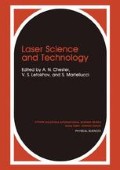Abstract
The coupling of laser sources and robotized systems for beam delivery and manipulation is one of the recent innovative aspects of laser technology for material processing. By introducing robot machines with moving optical components, the laser beam can be directed to the workpiece, under automatic control, with variable trajectories, speeds, angles or relative positions. This allows to control more precisely the manufacturing process and to take full advantage of the laser benefits, in terms of productivity and flexibility.
Access this chapter
Tax calculation will be finalised at checkout
Purchases are for personal use only
Preview
Unable to display preview. Download preview PDF.
References
Laserobotics 2, Proceedings 2nd International Conference Combining Laser and Robot Technologies, Southfield, SME (1987)
D. Belforte, M. Levitt editors, “The Industrial Laser Annual Handbook”, Pennwell Books (1986)
H. Kogelnik and T. Li, Laser Beams and Resonators, Proc. IEEE, 54:1312 (1966)
P. Perlo, Propagation of a multikilowatt laser beam: experimental characterization, in: “High Power Lasers and their Industrial Applications”, SPIE Proc. 650:178 (1986)
J. T. Luxon and D. E. Parker, Practical spot size definition for single higher-order rectangular-mode laser beams, Appl. Opt., 20:1728 (1981)
W. H. Carter, Spot size and divergence for hermite-gaussian beams of any order, Appl. Opt., 19:1027 (1980)
S. A. Self, Focusing of spherical gaussian beams, Appl. Opt., 22:658 (1983)
M. Sparks, Optical distortion by heated window in high power laser systems, Journ. Appl. Phys., 42:5029 (1971)
P. Belland, J. P. Creen, Changes in the characteristics of a gaussian beam weakly diffracted by a circulare aperture, Appl. Opt., 21:522 (1982)
G. Alessandretti and P. Gay, Characterization of coated CO2-laser optical components employed in an industrial plant, in: “Gas Flow and Chemical Lasers”, 1984, Adam Hilger Ltd., Bristol (1985)
Author information
Authors and Affiliations
Editor information
Editors and Affiliations
Rights and permissions
Copyright information
© 1988 Plenum Press, New York
About this chapter
Cite this chapter
Alessandretti, G., Perlo, P. (1988). Optical Design Considerations for CO2 Laser Industrial Systems. In: Chester, A.N., Letokhov, V.S., Martellucci, S. (eds) Laser Science and Technology. Ettore Majorana International Science Series, vol 35. Springer, Boston, MA. https://doi.org/10.1007/978-1-4757-0378-8_12
Download citation
DOI: https://doi.org/10.1007/978-1-4757-0378-8_12
Publisher Name: Springer, Boston, MA
Print ISBN: 978-1-4757-0380-1
Online ISBN: 978-1-4757-0378-8
eBook Packages: Springer Book Archive

